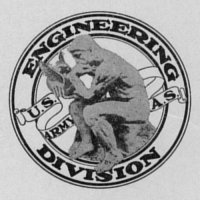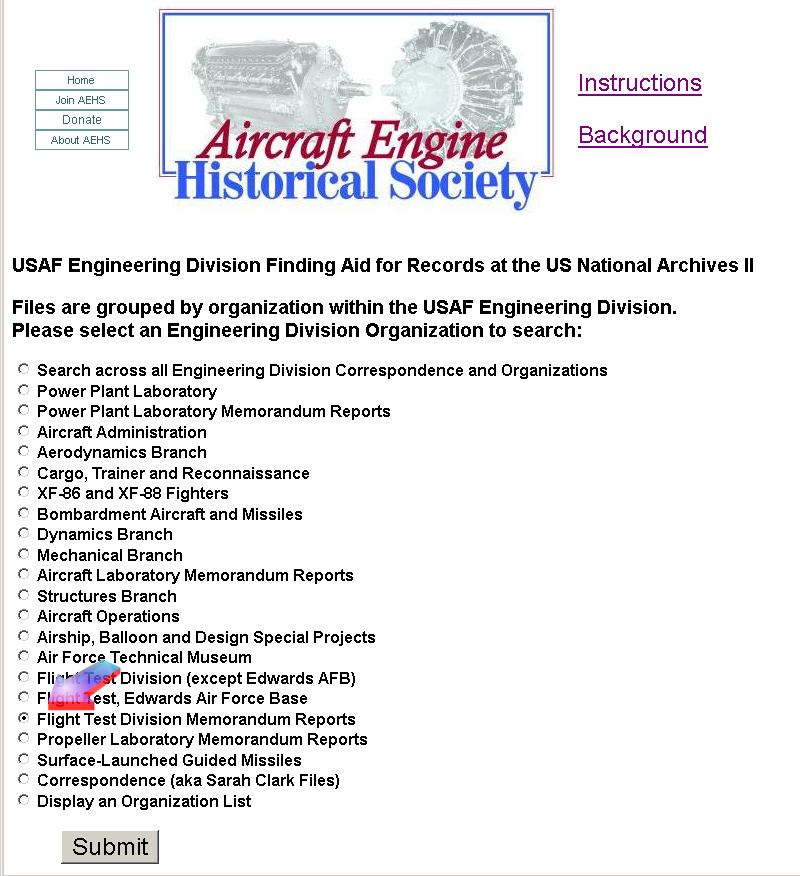USAF Engineering Division Finding Aid
Instructions for Searching Flight Test Divison, Aircraft Laboratory
and Power Plant Laboratory Microfilmed Memorandum Reports.
 |
The USAF Flight Test Division was responsible for flight-testing aircraft, engines, propellers and other equipment from 1929 until the 1960s. Records of these tests, along with documents and reports from many other Engineering Division organizations, were microfilmed during the early 1970s and now are stored at the U.S. National Archives and Records Administration (NARA) facility in College Park, Maryland. Over 4,000 reports comprise the Flight Test Division records collection, which is extremely rich in content. In addition to providing conceptual, developmental, testing and operational details of specific aircraft, they also document the development of doctrine, underlying science, materials, processes, procedures, and standards.
These instructions are for searching the Flight Test Division Memorandum Reports; the Search forms, Result forms and search techniques for the Aircraft Laboratory and Power Plant Laboratory are identical. |
Example Flight Test Division Reports
Instructions
Visit the Finding Aid, select the Flight Test Division Memorandum Reports radio button and click Submit

The Search Process
This search process involves a Search Form and a Results Form.
The Search Form
Below is part of an example Search Form:

Clicking the Search button with no search criteria specified produces a Results Form that can be used to browse the Flight Test Division documents. Here we have entered "P-51", which has produced the Results form that appears below.

The Results Form
Search criteria entered in the Search form and Results produced by the search may include abbreviations for the designers and manufacturers of aircraft, engines and propellers. A link to a current list of these abbreviations appears on both the Search and Results forms.
Click here for a current abbreviations list.
In order to specify useful search criteria, one must understand what appears on the Results Form, so we will cover it first and then return to the Search Form.
Please remember that the object of this finding aid is to tell one where the records are located at the National Archives II (hereafter Archives). One must still travel to the Archives in order to view most records. The finding aid makes a visit to the Archives much more productive. Result form fields are further explained below.
The Document # is analogous to a microfilm roll and frame.
Document #s are structured as follows: Orrffff where,
O = the Engineering Division Organization that originated the Memorandum Reports (A = Aircraft Laboratory; F = Flight Test Division; P = Power Plant Laboratory; R = Propeller Laboratory)
rr = the Microfilm Roll Number within the Organization's Microfilmed Memorandum Reports
ffff = the Frame Number on the Microfilm Roll
Hence, F121208 means that the Flight Test Division Memorandum Report begins on Flight Test Division Microfilm Roll 12, frame number 1208.The Date field specifies the date or date range during which a project was active. Conventions for the dates take several different forms:
Report # — Most projects produced one or more reports. In cases where the numbers of these reports are known, they are listed by Report #. Also listed are reports that may have been referenced in project correspondence. Like the Project/EO number, the Report #s help tie the raw data, correspondence and other project material together. Like the Project/EO #, the Report # structure evolved over time. We are still trying to understand the structure of report serial numbers. If anyone knows more about the structure of Report #x used by the Engineering Division, we would LOVE to hear from you!
The
Date field specifies the date or date range during which a project was active. Conventions for the dates take several different forms:
- yy -- a single year with the leading "19" omitted. (50 = 1950)
- yy yy yy yy -- a string of years separated by spaces. (36 38 39 41 = 1936, 1938, 1939, 1941)
- yymm -- year and month (4803 = March of 1948)
- yymm-yymm -- a range starting and ending with year and month (4803-4902 = March of 1948 thru February of 1949)
- yymmdd -- year, month and day (480618 = June 18, 1948)
- weyymmdd -- week ending year, month and day (we480618 = week ending June 18, 1948)
- yymmdd-yymmdd -- a range of dates (390726-390915 = July 26, 1939 thru September 15, 1939)
The Title field is the whole point of this Finding Aid. Titles were assigned by AEHS volunteer subject specialists and include keywords that will make searching easier.
The Contract/PO field identifies the government contract or purchase order under which a project was executed.
Proj/EO # — In the early days of McCook Field, R&D projects were apparently assigned project numbers and the contractual, technical and financial data associated with a project was stored under its project number. Early project numbers appear to have been assigned sequentially. As the Engineering Division grew and various projects were spread across multiple organizations, a more complex numbering system seems to have evolved. With the new system, numbers were apparently assigned to projects based on the budget line item that funded the project. Work on a project was authorized by an "Expenditure Order" (EO) that was charged to a budget item. Project data was now filed under these EO numbers. This scheme is confusing and troublesome to researchers, because the budget numbers changed from year to year, meaning that a certain EO number in 1921 was not necessarily the same kind of work in 1941. Despite its apparent problems and inconsistencies, it is by Project/EO number that technical data was filed. These numbers are referenced in reports, memoranda and correspondence, so they are of great importance in their ability to tie all the disparate elements of a project together. If anyone knows more about the history and use of EO numbers in the US Air Force from 1920 through 1950, we would LOVE to hear from you!
The Remarks field expands on the Title to provide additional information, such as the type and quantity of data.
Search Again: Clicking on Search Again returns to a CLEARED Search Form. If you desire to return to the search form and preserve the search criteria, use the browser's "BACK" button.
The Search Form Revisited

The Search Form allows one to specify criteria that govern the number of "hits" returned by the search. Note that one does not have to specify anything in any of the fields. The purpose of any search specification is to simply reduce the number of search hits to those meeting the specified criteria. When search criteria are specified, the search will return results matching ALL of the search criteria that are specified. Clicking the Search button with all of the fields blank returns as many "hits" as is specified by the Max Records pull-down menu located under DISPLAY OPTIONS.
One can search any of the fields that appear on the Results form by entering the appropriate search criteria on the Search form. The _ (underscore) wild card character may be used within most of the field specifications to match any single character.
The text of either the Title or Remarks fields can be searched by selecting either the Title or Remarks radio button and entering words or phrases into the next series of menus, which produce results as outlined below:
all of the words: results containing ALL of the words in this field (separated by spaces, in any order) are returned.
the exact phrase: results containing the exact phrase specified in this field are returned.
at least one of the words: results containing one of the list of specified words.
none of the word(s): results that contain any of the words in this field (separated by spaces), in any order, are excluded from the results returned.
The _ wild card character may be used within the Title or Remarks specification to match any single character.
DISPLAY OPTIONS
Sort by allows one to select which column on the Results Form will be used to sort the results.
Sort by pull-down menu allows selection of either RD #, Proj/EO #, Report #, Date, Title or Remarks. Results will be sorted in ascending order within the selected column. If no sort criteria is entered, results are returned in RD # order.
Max Records allows one to limit the maximum number of results that will be returned. The default is 25.
Visit the USAF Engineering Division the Finding Aid



